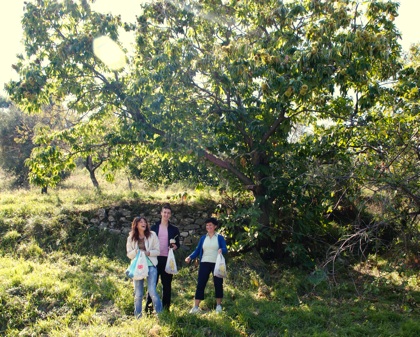Castanea sativa
European sweet chestnut καστανιά
Fagaceae - beech family Dicot.
Castanea sativa
European sweet chestnut καστανιά
Fagaceae - beech family Dicot.
The beautiful sweet chestnut trees are an important component of the deciduous broad leaf woodland on the island of Skopelos, it is well suited to the Mediterranean climate but grows only in acid or neutral soils. The trees tolerate shade but require moisture. It is a tall broad-leaf deciduous tree. The leaves are long and narrow with toothed edges, both male catkins and female flowers occur on the same tree, the unmistakeable fruit with a spiny husk containing two to four seeds with dark brown shiny coats, the sweet chestnuts.
The sweet chestnut tree
Castanea sativa
The sweet chestnut tree's origins were in the forest, which covered much of the northern hemisphere in the prehistoric era; it survived the last ice age in only a few small areas, refugia, along the southern shores of the Black Sea and in Mediterranean basin.1 From here the chestnut began to increase in number under the influence of early man. At this stage it was not valued as a food source but as a timber tree, but as it spread through Greece, arboricultural techniques led to improvement of the trees and their fruits and played a role in the developing vine-olive culture; 2 the coppiced trees provided pole to support vines.
By the 1st Century BC there were several important centres of chestnut cultivation in Greece, including Pelion and Evia. The ancient settlement, Kasthania, in the foothills of Mount Pelion was the centre of an export trade in chestnuts and is the probable origin of the Latin name, the scientific genus and the modern Greek name, Castanea (καστανιά).3 The Ancient Greeks took chestnut trees to Italy, and subsequently the Romans distributed them widely; the tree becoming a component of rural landscape not only in the Mediterranean region but also throughout mainland Europe as far north as Britain.
The sweet chestnut tree was of great significance in Medieval times, providing delicious, nutritious nuts as food for humans, fodder for animals, as a rich source of pollen for the production of honey and as a valuable timber tree; it makes excellent charcoal and is a rich source of tannin. Settlers took chestnuts to the New World, introducing them to a number of centres in S. America and later to Australia.
The importance of the tree for food declined when people moved from the countryside into towns during the industrial revolution and forests were decimated, as many trees were felled for tanning.
The sweet chestnut tree, castanea, has remained important in Greek culture to this day:
The famous forests of Mount Athos are the source of highly valued timber beams, used to build the traditional roofs and balconies of Skopelos.
Autumn chestnut festivals are still held throughout Greece in mountain regions.
Many Greeks, from the city or countryside, have fond childhood memories of eating chestnuts bought from street sellers on cold winter days or roasting them on the open fire.
On Skopelos, families go out each autumn to forage for chestnuts from their favourite tree.


1. Krebs, Condero et al.Quaternary refugia of the sweet chestnut (Castanea sativa Mill..)an extended palynological approach. Veget Hist Archaeobot (2004).
2. Condero, Krebs et al.The cultivation of Castanea sativa (Mill.) in Europe,from its origin to its diffusion on a continental scale. Veget Hist Archaeobot (2004).
3. Avantzo.(Editor). FOLLOWING CHESTNUT FOOTPRINTS. International Society for horticultural science.(2009)
